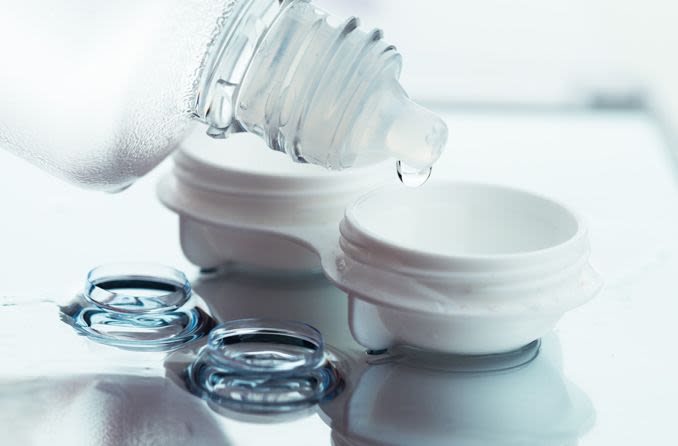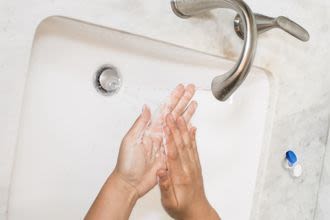Tips for keeping your contacts clean and your eyes healthy

The concept of placing tiny bowl-shaped lenses on one’s eyeballs can be intimidating. That’s just the beginning. How do you care for your contact lenses so you keep your eyes healthy?
During your eye test, opticians tell you how to properly use and wear contact lenses, but a 2019 survey for the U.S. Centers for Disease Control and Prevention found that one-third of contact lens wearers didn’t recall learning the do’s and don’ts of proper contact lens care.
So whether you’re a first-time wearer, or a contact lens veteran, we’ve broken up contact lens care do’s and don’ts into a few categories – application, cleansing and hygiene, lifestyle and disposal. Feel free to print these out as a free contact lens care cheat sheet.
Application, cleansing and hygiene

Do:
Do wash and dry your hands thoroughly before handling your contacts.
There are a lot of bacteria on your hands, so failing to wash them could contaminate your contact lenses and, in turn, your eyes. Drying your hands is also important because it’s easier to transmit germs through wet hands than dry ones.
Do keep your contact lens case clean.
The American Optometric Association recommends cleaning your case with contact solution after each use and keeping it open to air-dry between cleanings to prevent bacteria growth.
Do clean and disinfect your lenses after each use.
After you’ve worn your two-week or monthly contact lenses, it’s important to clean them before storing them.
After filling each chamber of your contact lens case with fresh disinfecting solution, take turns placing each lens in your palm with a few drops of cleaning solution and rubbing it back and forth to clean the surface.
Then, rinse each lens with more solution and place it into the case for storage.
Don’t:
Don’t clean or store your contact lenses in tap water or saliva.
Avoid getting tap water on your contacts and case, as water can carry a microorganism called Acanthamoeba that causes serious eye infections, the CDC says. Saliva is even worse, as it contains even more microorganisms.
Don’t "top up" cleaning solution.
According to the National Eye Institute, old solution can have contaminants in it, which will affect whatever new solution is added.
Think of it this way: Would you bathe in yesterday’s bath water if you only added some fresh water to it? Didn’t think so. It’s better to play it safe and only use fresh cleaning solution.
Don’t store your contact lens case in the bathroom.
Bacteria thrive in humid environments such as bathrooms, so while it might make sense to keep your contact lens case by the sink, you’re also putting yourself at greater risk for contamination.
And that’s before you consider all the pathogens coming out of your toilet’s splash zone!
SEE RELATED: Contact Lens Myths
Lifestyle
Do:
Do remove contact lenses before showering, bathing or swimming.
The chemicals and bacteria found in water can get trapped between your lens and your eye, causing irritation and potential infection.
Do discard contacts that have been contaminated with water.
The National Eye Institute suggests that if contact lenses are worn during swimming, showering or bathing, they should be thrown out or disinfected overnight.
These precautions ensure that if any harmful substances get trapped in your lenses, there’s a smaller chance of them affecting your eye.
Do be mindful when rubbing your eyes.
If you rub your eyes too vigorously, you can damage your cornea, cause your contact lens to fold and fall out of your eye, or worse, trap your contact under your eyelid. Be as gentle as possible when rubbing your eyes, or better yet, just don’t do it.
Don’t:
Don’t sleep in your contact lenses.
Unless your optician tells you otherwise, it’s important to remove and clean your contacts before you go to bed. Sleeping in contacts after they’ve collected dirt, pollutants and bacteria throughout the day can increase your risk of infection and irritation, even with “extended wear” contacts.
Don’t wear contact lenses if you’re ill.
Whether you have a cold, the flu or seasonal allergies, you should not wear your contacts when you’re under the weather. Not only are contacts more likely to irritate your eyes when you’re ill, they’re also more likely to lead to eye infections such as conjunctivitis.
Don’t expose or store lenses in excessive heat.
In case you were wondering, contacts can’t melt in your eyes (unless you’re physically on fire, in which case, you have bigger problems). However, exposing your contacts to prolonged or excessive heat can dry them out and irritate your eyes.
Disposal
Do:
Do follow your recommended replacement schedule.
Your optician will tell you how long you can wear (and keep) your contacts before changing them. Remember: Timelines (one-day, two-week, one-month, etc.) generally refer to how long contact lenses can be open before they should be replaced, not how many days they can be worn.
Do replace your lens case every three months.
By getting a new contact lens case you discard any built-up bacteria where you store your contacts and provide a clean and safe place for when you’re not wearing them.
Do find a location to recycle your contact lenses.
You’d be surprised how many places accept and recycle contact lenses. Collect your contacts and packaging in a recyclable bag then find a participating vision center where you can drop them off.
Don’t:
Don’t flush contact lenses or rinse them down the sink.
A 2018 study of contact lens wearers found 15-20% were flushing their old contacts down the toilet or washing them down the sink's drain. This habit contributes 20-23 metric tons of plastic trash winding up in our wastewater each year.
Don’t mix contact lenses with other garbage.
Adding contact lenses to your everyday trash means that plastic won’t flow into our water systems, but it’s still being dumped at a landfill. The best way to dispose of your contact lenses is to recycle them at a participating shop.
Don’t put contact lenses in the recycling bin.
Due to their size and packaging materials, non-specialized recycling facilities typically can’t handle contact lenses so they are diverted to landfills. It’s best to deliver contacts and their packaging to a designated recycling location.
Just stick to the above list and you should get an A in contact lens care the next time you see your optician. Contact lens do’s and don’t are pretty much common sense, but as the CDC survey discovered, one-third of contact lens wearers don’t recall ever being told how to care for their contacts.
IS IT TIME TO GET NEW CONTACTS? Find an eye doctor near you.
Page published on Tuesday, 25 February 2020






